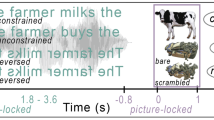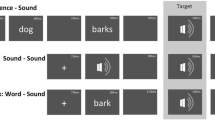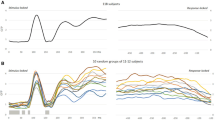Summary
We analyzed topography and strength of 20 channel event-related potential maps to sentence endings differing in correctness, verbal vs. nonverbal surface form, priming, and repetition count. Seventeen healthy subjects silently read correct and incorrect versions of simple sentences with predictable color endings, and of more complex sentences with predictable composite word endings. Color endings appeared in verbal and nonverbal form. Measures of map topography (centroids of the positive and negative areas of the average referenced maps) and strength (Global Field Power) were analyzed. Adaptive segmentation distinguished a pre-N400 and a N400 microstate in the N400 time range. Topography differed between these two microstates, between verbal and nonverbal endings, and between correct color, incorrect color, and incorrect noncolor words. All verbal endings evoked left-lateralized negativity and right lateralized positivity in the pre-N400 microstates. Correct verbal endings evoked consistent posterior positivity and anterior negativity with left-lateralized gradient strength suggesting language-specific processing. New, incorrect noncolor words evoked reversed anterior-posterior N400 and pre-N400 map topographies with more anterior positivity and more posterior negativity than correct colors in each subject. Gradient strength and current source density maps also differed from those to correct colors. Strongest gradients were left-posterior in the pre-N400 but anterior in the N400 microstate, consistent with anterior activity contributing to the posterior N400 negativity. Incorrect and correct colors, which were semantically primed and repeated, showed smaller topographic differences and N400 effects with a different topography. These different maps can not arise by modulation of a single pattern of neural activity and show that the N400 time range consists of multiple distinct microstates.
Similar content being viewed by others
References
Bentin, S., McCarthy, G. and Wood, C.C. Event-related potentials, lexical decision and semantic priming. Electroencephalography and Clinical Neurophysiology, 1985, 60: 343–355.
Besson, M., Kutas, M. and Van Petten, C. An event-related potential (ERP) analysis of semantic congruity and repetition effects in sentences. Journal of Cognitive Neuroscience, 1992, 4: 132–149.
Boddy, J. Event-related potentials in chronometric analysis of primed word recognition wit different stimulus onset asynchronies. Psychophysiology, 1986, 23: 232–245.
Brandeis, D. and Lehmann, D. Event-related potentials of the brain and cognitive processes: Approaches and applications. Neuropsychologia, 1986, 24: 151–168.
Brandeis, D. and Lehmann, D. Segments of ERP map series reveal landscape changes with visual attention and subjective contours. Electroencephalography and Clinical Neurophysiology, 1989, 73: 507–519.
Brandeis, D., Lehmann, D. and Mingrone, W. N400 maps in sentence reading: robust topographic changes and priming. Brain Topography, 1990, 3: 247–248.
Brandeis, D., Naylor, H., Halliday, R., Callkway, E. and Yano, L. Scopolamine effects on visual information processing, attention and event-related potential map latencies. Psychophysiology, 1992, 29: 315–336.
Brandeis, D., Vitacco, D. and Steinhausen, E. Mapping brain electric micro-states in dyslexic children during reading. Acta Paedopsychiatrica, 1994, 56: 239–247.
Brown, W.S. and Lehmann, D. Verb and noun meaning of homophone words activate different cortical generators: A topographical study of evoked potential fields. Experimental Brain Research, 1979, 2: 159–168.
Brown, W.S., Marsh, J.T. and Smith, J.C. Contextual meaning effects on speech evoked potentials. Behavioral Biology, 1973, 9: 755–761.
Brown, W.S., Marsh, J.T. and Smith, J.C. Evoked potential waveform differences produced by the perception of different meanings of an ambiguous phrase. Electroencephalography and Clinical Neurophysiology, 1976, 41: 113–123.
Chapman, R.M., McCrary, J.W., Chapman, J.A. and Martin, J.K. Behavioral and neural analyses of connotative meaning: word classes and rating scales. Brain and Language, 1980, 11: 319–339.
Curran, T., Tucker, D.M., Kutas, M. and Posner, M.I. Topography of the N400: brain electric activity reflecting semantic expectancy. Electroencephalography and Clinical Neurophysiology, 1993, 88: 188–209.
Deacon, D., Breton, F., Ritter, W. and Vaughan, H.G., Jr. The relationship between N2 and N400: Scalp distribution, stimulus probability, and task relevance. Psychophysiology, 1991, 28: 185–200.
Hirata, K. and Lehmann, D. N1 and P2 of frequent and rare event-related potentials show effects and after-effects of the attended target in the oddball-paradigm. International Journal of Psychophysiology, 1990, 9: 293–301.
Holcomb, P.J. and Neville, H.J. Auditory and visual semantic priming in lexical decision: a comparison using event-related potentials. Language and Cognitive Processes, 1990, 5: 281–312.
Karniski, W., Vanderploeg, R. and Lease, L. Virtual N400 and Slow Wave topography to auditory sentence incongruity. Brain and Language, 1993, 44: 58–79.
Katayama, J. and Yagi, A. Negative brain potentials elicited by an unexpected color patch or word. Electroencephalography and Clinical Neurophysiology, 1992, 83: 248–253.
Kavanagh, R.N., Darcey, T.M., Lehmann, D. and Fender, D.H. Evaluation of methods for three-dimensional localization of electric sources in the human brain. IEEE Transactions on Biomedical Engineering, 1978, 25: 421–429.
Koenig, T. and Lehmann, D. Microstates in language-related brain potential maps show noun-verb differences. Brain and Language, in press.
Kutas, M. and Hillyard, S.A. Reading senseless sentences: brain potentials reflect semantic incongruity. Science, 1980, 207: 203–205.
Kutas, M. and Hillyard, S.A. Event-related potentials to grammatical errors and semantic anomalies. Memory & Cognition, 1983, 11: 539–550.
Kutas, M. and Hillyard, S.A. Brain potentials during reading reflect word expectancy and semantic association. Nature, 1984, 307: 161–163.
Kutas, M. and Van Petten, C., Event-related brain potential studies of language. In: J.R. Jennings and M.G.H. Coles (Eds.), Advances in Psychophysiology, Vol. 3, JAI Press, Greenwich, CT, 1988: 139–187.
Kutas, M. and Van Petten, C., Electrophysiological perspectives on comprehending written language. In: P.M. Rossini and F. Maugiere (Eds.), New Trends and Advances in Clinical Neurophysiology, Vol. 41, Elsevier, Amsterdam, 1990: 155–167.
Kutas, M., Lindamood, T.E. and Van Petten, C., Word expectancy and event-related brain potentials during sentence processing. In: S. Kornblum and J. Requin (Eds.), Preparatory States and Processes, Lkwrence Erlbaum, Hillsdale, NJ, 1984: 217–237.
Kutas, M., Hillyard, S.A. and Gazzaniga, M.S. Processing of semantic anomaly by right and left hemispheres of commissurotomy patients. Brain, 1988, 111: 553–576.
Lehmann, D., Spatial analysis of evoked and spontaneous EEG potentials. In: N. Yamaguchi and K. Fujiskwa (Eds.), Recent advances in EEG and EMG data processing, Elsevier, Amsterdam, 1981: 117–132.
Lehmann, D., Principles of spatial analysis. In: A. Remond and A. Gevins (Eds.), Handbook of Electroencephalography and Clinical Neurophysiology, Vol 1: Methods of analysis of brain electrical and magnetic signals, Elsevier, Amsterdam, 1987: 309–354.
Lehmann, D. and Skrandies, W. Reference-free identification of components of checkerboard-evoked multichannel potential fields. Electroencephalography and Clinical Neurophysiology, 1980, 48: 609–621.
Lehmann, D. and Skrandies, W. Spatial analysis of evoked potentials in man — a review. Progress in Neurobiology, 1984, 23: 227–250.
Mitchell, P.F., Andrews, S. and Ward, P.B. An event-related potential study of semantic congruity and repetition in a sentence-reading task: effects of context change. Psycho-physiology, 1993, 30: 496–509.
Müte, T.F., Heinze, H.J. and Prevedel, H. Ereigniskorrelierte Hirnpotentiale reflektieren semantische und syntaktische Fehler bei der Sprachverarbeitung. Zeitschrift für EEG und EMG., 1990, 21: 75–81.
Neville, H.J., Kutas, M., Chesney, G. and Schmidt, A.L. Event-related brain potentials during initial encoding and recognition memory of congruous and incongruous words. Journal of Memory and Language, 1986, 25: 75–92.
Nigam, A., Hoffman, J.E. and Simons, R.F. N400 to semantically anomalous pictures and words. Journal of Cognitive Neuroscience, 1992, 4: 15–22.
Nunez, P.L. Electric Fields of the Brain, New York: Oxford University Press, 1981.
Rosengren, I. Ein Frequenzwoerterbuch der deutschen Zeitungssprache, Vol. 2, Koepenhamn: Villadsen & Christensen, 1977.
Rugg, M.D. The effects of semantic priming and word repetition on event-related potentials. Psychophysiology, 1985, 22: 642–647.
Sandini, G., Duffy, F.H. and Romano, P. Spatiotemporal analysis of cerebral evoked potentials. In: F.H. Duffy (Ed.), Topographic mapping of brain electric activity, Butterworths, Boston, 1986: 295–324.
Stuss, D.T., Picton, T.W. and Cerri, A.M. Searching for the name of pictures: an event-related potential study. Psychophysiology, 1986, 23: 215–223.
Van Petten, C. and Kutas, M. The use of event-related potentials in the study of brain asymmetries. International Journal of Neuroscience, 1988, 39: 91–99.
Van Petten, C., Kutas, M., Kluender, R., Mitchiner, M. and McIsaac, H. Fractionating the word repetition effect with event-related potentials. Journal of Cognitive Neuroscience, 1991, 3: 131–150.
Author information
Authors and Affiliations
Additional information
We are grateful to Walt Karniski, M.D. and to Dr. Barbara Henggeler for helpful discussions. This research was supported by grants 31-9395.88 and 31-30274.90 from the Swiss National Science Foundation.
Rights and permissions
About this article
Cite this article
Brandeis, D., Lehmann, D., Michel, C.M. et al. Mapping event-related brain potential microstates to sentence endings. Brain Topogr 8, 145–159 (1995). https://doi.org/10.1007/BF01199778
Accepted:
Issue Date:
DOI: https://doi.org/10.1007/BF01199778




